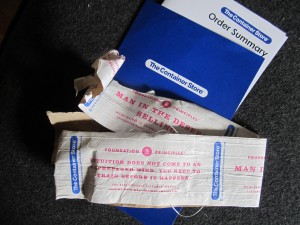
My wife loves the Container Store. She has a closet full of Elfa components and various other elements that roll around or sit under shelves. Recently she bought four big stacking wire baskets to hold mittens, hats and other snow gear, one for each family member. The box arrived (several days before the promised date, by the way) and it was as big as a steamer trunk. I’d assumed that shipping, an unhappy necessity for those who don’t live near a store, was similar to what they charge at Ikea—an arm and a leg. Not so; this was shipped at a flat rate of $19.95.
Before I knew this I had opened the package and became somewhat intrigued by a couple of its features. First, there was a special heavy-duty fiber tape used to seal the box which had CS’s “7 Foundation Principles” printed on it in an endless loop. These can be found on the website along with lots of comments and inspiring videos. CS is consistently voted one of the best places to work in America and its employees are fervent in their mission. To me the dialog seems a bit cultish but that’s just my perspective and I do not begrudge the employees or their customers their enthusiasm.
Second, the bill of lading was packaged in a little blue portfolio including a thank you from the President. It was at this point I decided shipping must be REALLY expensive so I peeked inside and there were no prices on the receipt. Then I went online and discovered how reasonable their shipping actually is.
Bottom line, this is a great fulfillment effort that extends the Container Store brand right into the home as the package arrives. The cost of the special tape and the card-stock portfolio are not insignificant but my guess is they haven’t been tested against a generic approach. Container Store felt this is the way to communicate with their customers, and that’s the end of it.
The whole experience puts to shame mass produced efforts like Lands End, from whence your coveted fashions arrive in a plastic sack and a return label is printed on your shipping document as if they assume you’re already having second thoughts. Amazon with its non-recyclable receipts, in which the UPC code for the package is printed on peel-off paper and then switched to the outside of the package leaving a blank spot on the receipt, isn’t much better. Not as bad as Applebee’s decision to just throw it in a box, but not great.
Fulfillment is the last mile in your relationship with your customer. There may be sound economic reasons that you can’t be as effusive as the Container Store. But consider their example, and learn from it.
